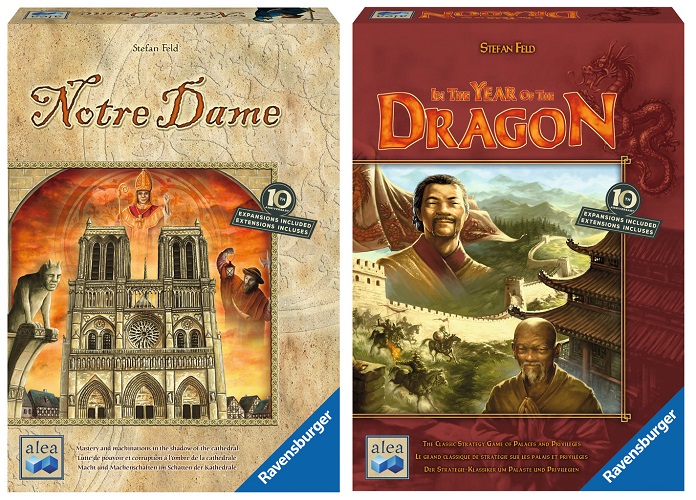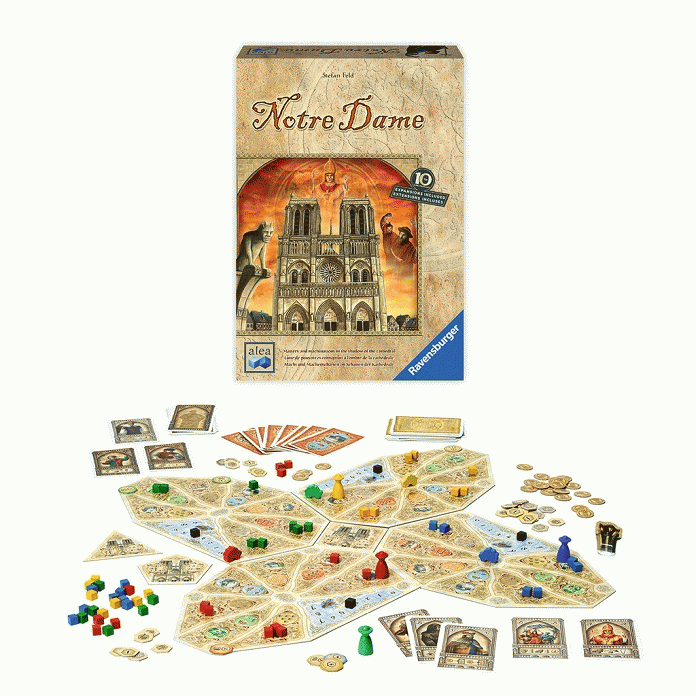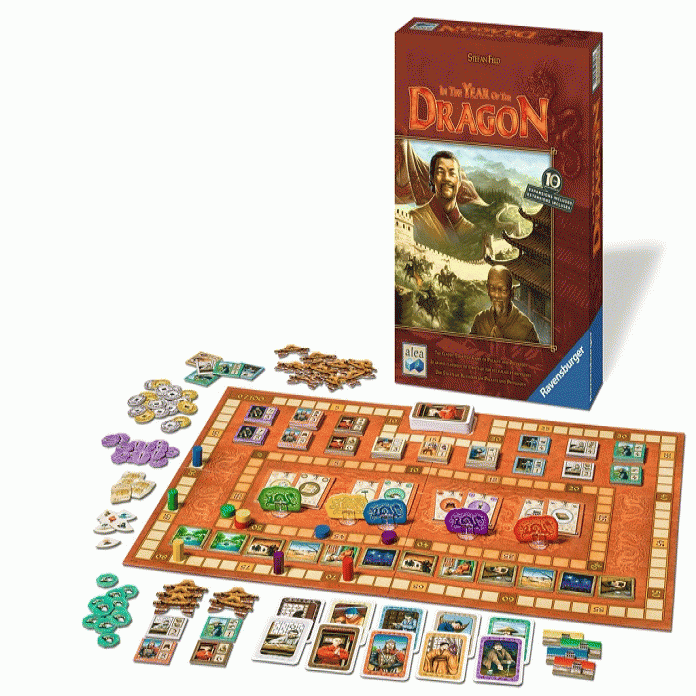
The PLAYlist 07: Notre Dame & In the Year of the Dragon 10th Anniversary Editions
If board game designers were indie rock’s elder statesmen, then German designer Stefan Feld would be Radiohead’s Thom Yorke. He’s a tried-and-tested critical darling, with an unbelievably strong track record of games to his name. Any new box bearing his name will be enough to get gamers to at least take a look. His respect in the industry is well-earned, and even if his stuff isn’t to your taste, you can’t deny how elegant so many of his game systems are.
Feld’s best-known design, 2011’s The Castles of Burgundy – or, as it’s infinitely more fun to say in German, Die Burgen von Burgund – is the one that most gamers can agree upon. It’s his masterpiece: complex yet approachable, and something that you’ll return to again and again. It’s his OK Computer, if you will. But just because it’s the one that everybody likes, that doesn’t mean it’s everyone’s favorite. Like how some music fans prefer the organic comfort of Radiohead’s In Rainbows, some gamers prefer the relative open-endedness of Feld’s more recent hit, Trajan. Likewise, there are people who prefer his somewhat more straight-forward early releases, such as Notre Dame or In the Year of the Dragon. Those are the same type of people who would tell you Radiohead peaked with Pablo Honey or The Bends.
(If you were to force me to continue my board game designer/alternative rocker analogies: Vlaada Chavatil is Beck, Uwe Rosenberg is Stuart Murdoch, Alan Moon is Dave Grohl, Martin Wallace is Damon Albarn, Richard Garfield is Trent Reznor, and Reiner Knizia is Robert Pollard. I’ve spent a lot of time thinking this through. Trust me.)
These two early, notable Feld titles I just mentioned – Notre Dame and In the Year of the Dragon – are receiving special 10th Anniversary Editions this summer. These re-releases arrive relatively unchanged from their original versions, save that Ravensburger have now included their expansions in the box so that players experiencing them for the first time will be able to do so with a bevy of extra options, adding variety to their gaming sessions. Let’s talk about each of those games, shall we?

Notre Dame
Your eyes will no doubt be drawn to Notre Dame’s attractive, modular play area, with its player boards that sprout from its centerpiece like petals on a lily. For a game with such an aggressively beige color palette, it manages to look real purdy on the table.
In Notre Dame, you star as the head of bourgeoisie 14th Century family living in the heart of Paris. As a hunchback rings the bells in the stately Notre Dame cathedral, you keep yourself busy carting around your neighborhood barking orders at your employees. “Gussy up that park over there, peasant!” you shout, pinching your moustache between thumb and forefinger. “Why don’t you hang out in that yonder hospital, huh?” Your purpose in life is to exert maximum influence across your ‘hood, because in the end the person with most prestige will, basically, be the coolest person in France.
Oh, and you spend a great deal of time killing rats. Lots and lots of rats.
So, the theme of Notre Dame doesn’t necessarily come through too clearly. (Save for the theme of dirty, stinking rats, which will just pile up in your harbor if you don’t take proper care of them.) It’s a nice-looking game, but you’ll never feel like you’re an actual medieval French noble investing in public services, or anything so thrilling. Thankfully, though, the gameplay systems are far better at capturing players’ attention.
The game takes place over nine rounds. At the beginning of each, players draw three cards from the top of their action deck – each player starts with an identical deck – from which they choose one, and then pass the remaining two cards to their side. From this new hand they pick another card, then pass the last one to the player next to them. Each of these cards represents an action you can play in the next phase of your turn. They allow you to place influence cubes of your color on the appropriate space on your board which, in turn, will grant you points, money, more influence cubes, or allow you to move your carriage or kill a few of those darn rats. These actions are made more powerful by the number of cubes you have on a space, so the more you repeat an action, the better it gets. (For example, the bank gives you one coin the first time you use it, two the second, and three the third.) However, you’re limited by the fact that there is only one copy of a card in each deck, meaning you likely won’t see any particular card as often as you’d like.
Drafting cards gives Notre Dame a nice interactive element that makes it stand out from drier, more stereotypical European-style board games. When mulling over the cards in your hands, you can look at your opponents’ boards to guess what strategies they’re following, and maybe pick a card just so they won’t have a chance to use it. (You only use two of your three cards each turn – the third goes into the discard pile, hidden away from your opponents.) While playing, you’re often forced to think tactically, on your feet, and can pivot to cash in any opportunities your opponents may have unwittingly passed your way.
And oh, right. The rats.
In the last phase of each round, players can pay money to use one of three randomly-displayed person cards. Each grants a special power and – because they’re flipped at the beginning of a round – can sometimes shape the strategy you take while drafting. Pictured at the bottom of these cards, though, are those dang rats I keep talking about. Unless you’ve pre-arranged means of preventing it, at the end of each turn you’ll move your rat cube – the ugliest of ugly, little black cubes – up the rat track that many spaces on your board. If you cap out, you’ll have to pay with victory points and influence cubes. It’s devastating. If you want to win in Notre Dame, you’d darn well better keep your rats in check.
And that’s the shake of it, more or less. The rulebook can be a little obtuse, but once you grasp the game it’s pretty easy to teach. The drafting makes it feel more interactive than many other games of this genre and it moves along faster – 45 to 60 minutes, but it feels quicker – than some of Feld’s later designs. The new, 10th Anniversary edition includes an expansion which adds more special person cards to the deck – this brings a lot more variety to the base game, and we’d recommending mixing it in from the very beginning.
It’s worth noting that while the box supports two to five players, the two-player version has a dramatically different feel to it. With only one opponent, you’ll be passing draft hands back and forth – meaning, the third card you’ll get each round is coming back to you from the hand you originally drew. Playing this way, you’ll always know what two out of three cards in your opponent’s hand are going to be, which sucks a lot of the fun mystery and guessing out of the game. Notre Dame needs to be played with at least three people in order to really hum, so bear that in mind.

In the Year of the Dragon
Also turning 10 years old this summer is In the Year of the Dragon, Stefan Feld’s classic game of Chinese castle-building, courtier-courting, and fireworks hording. Ravensburger’s Anniversary Edition arrives packed with several expansions which add more wrinkles of complexity to the game, if you so choose to use them.
Set in 1,000 AD, you play a Chinese nobleman or woman in charge of a growing estate. As it turns out, though, the early 11th century was apparently a pretty crappy to be doing such a thing. As you go about hiring new craftspeople to populate your fancy villas, disaster strikes at every turn: plague, famine, Mongol invasion, tax day. It’s your job, as shepherd to this flock of monks, farmers, and firework-makers, to keep everyone safe and alive through these never-ending cataclysms. As if that weren’t enough, you have to worry about your shoddily-built palaces collapsing any time one of your employees wanders out of the place.
At the start of the game, Dragon’s 12 event tiles – or, as they should be called, the “screw you tiles” – are shuffled up and set out across the bottom of the board. These represent the (mostly terrible) things that will happen at the end of each of the game’s twelve turns. Outside of the two peace tiles (which always come at the beginning of the track) and two tiles where everyone throws a big, ol’ fireworks party, these tiles herald famine, taxes, contagion, or invasion. If you’re not able to offset these events with the proper amount of food, money, war tokens or doctors in front of you, your courtiers start dying and castles start falling down. It’s bad, so y’all better be prepared.
That preparation makes up the bulk of In the Year of the Dragon. During each turn, a set of seven action cards are shuffled and randomly sorted into piles equal to the number of players at the table. Beginning with the player furthest ahead on the people track – this is determined by the numbers on the courtiers living in your palaces – you choose one set of those cards, and execute one of the actions there. These range from adding new floors to your palaces, to harvesting food, crafting fireworks, taking money from the bank, or just earning victory points. (If you have such luxury to do so.) The more of the corresponding courtiers you have living in your palace, the more effective that action will be.
Each player starts with an identical set of 11 person cards, and in the next phase of the round you’ll get to choose one and play it. These match up with courtiers stacked at the top of the board, and the card you play will allow you to take a dude token of that type. Most of these guys come in two styles: a more powerful version with a lower number in the corner, or a less powerful version with a higher number. Those numbers determine how far up the person track your token will move, which determines the order you’ll pick action cards the next turn. Sometimes it’s worth it to take a weaker courtier in order to get first pick of actions on the next go-round.
Each round ends with the players resolving one of those wretch event cards at the bottom of the board. This is where you need to pay up with those food, money, and other tokens you’ve been building up across the action phases. If you can’t, well, you’ll start hemorrhaging courtiers and castle pieces. This would feel like a setback you might not be able to recover from, were it not near-impossible to make it through the game unscathed. Every player, unless they’re really skilled and really lucky, will have to take their turn braving one shitstorm or another.
At the end of the last round, you tally up your score and the player with the highest, of course, is the winner. It’s a somewhat longer game than Notre Dame, but the pace feels good, and there’s never any question about how much time you have left thanks to those event tiles, which tick down as each round passes. Given that you can see those event titles in advance and that will dictate (to a degree) the moves you’ll make each turn, In the Year of the Dragon seems a little less open-ended as to where you need to go. Players who like being given some direction will welcome that, while it’s possible that those who enjoy their relative freedom to choose their own strategies will be put off. The theme – being a Chinese nobleman with zero luck when it comes to plagues, droughts, and raiding parties – is a lot more cohesive than in Notre Dame. To some, In the Year of the Dragon will feel brutally punishing. Even more so than Notre Dame’s rat problems, this is a game design that’s less about getting ahead and more about screwing up less than everyone else. That said, I really like In the Year of the Dragon – I’d probably give it a slight edge of Notre Dame. The included Great Wall expansion adds another action card, and the super events expansion adds a bigger event – some good, some bad – that happens once per game, and isn’t shown in advance.
Like Notre Dame, this is a game that really needs more than the minimum two players to truly function as it should. If you’re playing with only one other person, there’s plenty of room to maneuver without much getting in one another’s way. Without serious competition for the action cards, it’s possible to look ahead at the upcoming catastrophes and simply prepare for them as you get around to it. (The two player game can feel like you’re just going through motions.) Small games can suffer from a runaway leader problem, too – if one player jumps ahead early on the person track, there’s not much their opponent can do to catch up with them. For that reason, we won’t recommend the game if you’re not regularly getting three or more people around your table.
In the end, both Notre Dame and In the Year of the Dragon hold up very well after a decade, and prove themselves worth of these anniversary edition reissues. If we were going to recommend one game to a first-time Feld player, we’d still go with Castles of Burgundy – it’s really his easiest-to-love, most fun-to-play design. (And still readily available from Ravensburger through your favorite board game provider.) If you’re already a Burgundy fan, though, and craving more of that distinctly Feld-y, German action, either of these are worth a look. Want something quicker and lighter? Check out Notre Dame. Want more of a challenge? Go with In the Year of the Dragon.
For this column’s playlist, we’ve served up a sweet selection of tunes from 2007 – the year both of these games were first released. It was an absurdly good year for indie music, with career-defining records from Animal Collective, Jens Lekman, M.I.A., Spoon, of Montreal, and The National, and stunning debuts from UTR favorites like Bon Iver and Yeasayer, among others. Here are two hours for you to enjoy as you play these games, surf around on the internet, or just hang out at home or the office. It’s up to you, really! We supply the music, you do what you want with it.
Keep checking back for future installments of The PLAYlist. We can be board game friends, a’ight?
***
Previous PLAYlist columns: Yokohama, Clank! A Deck-Building Adventure, Villages of Valeria, New York Slice, Watson & Holmes, Hanamikoji.
Current Issue

Issue #72
Apr 19, 2024 Issue #72 - The ‘90s Issue with The Cardigans and Thurston Moore
Most Recent
- Bat For Lashes Shares a Cover of Baauer’s “Home” From Her New Album (News) — Bat For Lashes, Baauer
- The Decemberists Share New Song “All I Want Is You” (News) — The Decemberists
- Ella McRobb Releases New Single “Slow Motion Heartbreak” (News) — Ella McRobb
- Light Verse (Review) — Iron & Wine
- Linn Koch-Emmery Drops New Single “No Hands” (News) — Linn Koch-Emmery

Comments
Submit your comment
August 21st 2018
1:05am
Say thank you I searching for your facts
Sifli black magic